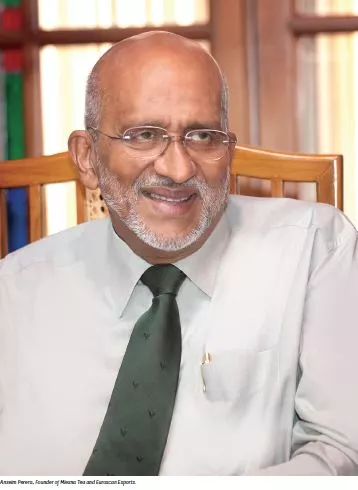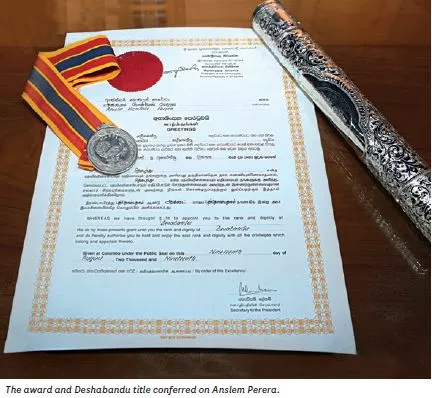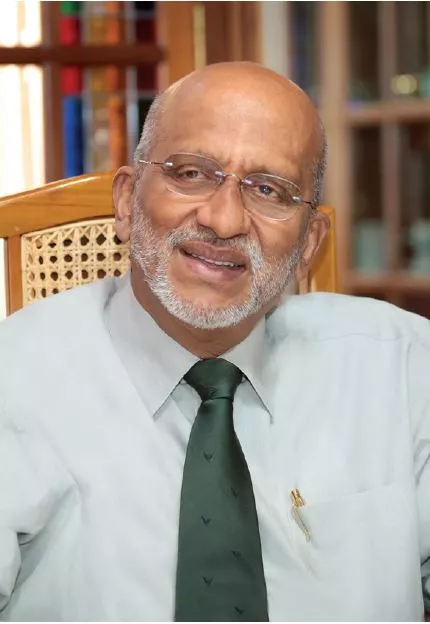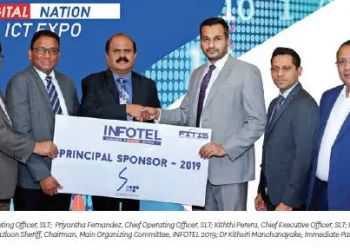
His association with Ceylon Tea, perceptibly modern, is well-known. As the doyen of the 20th century ‘tea renaissance’ he has donned many accolades and recently received national recognition for engendering a resurgence in Ceylon Tea by creating a brand of global stand-ard, while robustly supporting the efforts to sustain the industry. Anselm Perera, Founder of Mlesna Tea and Euroscan Exports, and past Chairman, Colombo Tea Traders’ Association (CTTA) was awarded the National Honor of Deshabandu.
By Udeshi Amarasinghe and Jennifer Paldano Goonewardena. | Photography Mahesh Bandara and Menaka Aravinda.
Your story as a specialist of Ceylon Tea has been well narrated before. But your epic journey has been crowned with a National Honor bestowed only upon a chosen few. Tell us your journey, including the accolades that you have received?
From an ambition to be an engineer as a school boy to my entry into the tea trade happened not so much by choice, but as a result of circum-stances. When I was chosen as a Trainee Tea Taster by Brooke Bond in 1969, I was the only candidate who made the mark out of 74 applicants following a rigorous selection process of several interviews. I started my first job right after my A’ Level examination. My ten years at Brooke Bond was a period of growth and learning, where I honed my skills through training in the UK and gained experience working in Sri Lanka and in the course of a stint in Pakistan. I joined Shaw Wallace and Hedges as Tea Manager and my promotion to Tea Director within a short time allowed me to travel the world, which opened the door to more learning.
It was not the best of times when I ventured on my own in 1983 to set up Mlesna, which, those who are familiar with the brand know is a mirror image of Anselm. When the July 1983 ethnic riots erupted just a week after I had started Mlesna, I believed that my business would be doomed. There was so much violence around the country and the war that followed as a result for over 30 years has had a disastrous effect, so much so my tea outlet in Bandarawela failed to make a profit throughout those years. Yet, after 36 years,I can proudly say that Mlesna has survived the struggle and has been recognized with awards under different categories.
Starting from 1986, my company has won 17 awards and four merit certificates at the Presi-dential Export Awards; 30 awards and six merit certificates at the Lanka Star National Packaging Awards for Excellence in Packaging; 18 awards at the Asia Star Asian Packaging Awards; seven Gold awards, two Silver awards and two Bronze awards at the National Exporters Awards; and nine awards at the World Star International Awards. In addition, my company was also rec-ognized with the Global Commerce Excellence Award in 2014, and we also received the Highest FOB Achiever for Bulk Tea and Highest FOB Achiever for Value Added Tea in 2017 at the National Tea Awards and again the same year was recognized by BT Options with the Business Today Passionate Award. This year, I was presented with the National title of Deshabandu. I feel privileged and I am grateful to be among a group of selected individuals to be bestowed with such an eminent national honor.
Receiving an award for value added tea speaks greatly on the importance you place in innovation and change. What defines the brand Mlesna as a trendsetter in terms of offering value additions?
I was able to transform Ceylon Tea through Mlesna by focusing on higher grades of quality tea. Mlesna’s product range extends from leaf tea and tea bags to specialty teas, flavored teas, special products and a large array of gift teas and tea accessory products. I have managed to posi-tion Mlesna in the gift tea category by offering unique packaging such as porcelain jars, exclusive tea sets, and ornate figurines that blend with the concept of Ceylon Tea.
I broke away from the tradition of shipping tea, as a commodity and focused on creating a brand that would be a finished product. My strategy has been to reach out to my target mar-ket segment by emphasizing the values of pure Ceylon Tea. For instance, I tie up cultural and traditional sentiments when I make a new blend, like British colonialism, this in a way attracts a segment that cherishes a certain value associ-ated with a particular blend.
I wanted to create a brand that would display the history of our tea legacy, along with our Sri Lankan heritage, culture and history. My value additions include the blending of Sri Lankan herbs and spices with tea, which also promote health, while introducing the flavors of Sri Lankan fruits, and these unique teas can be drunk at any time of the day, either hot or cold. More importantly, we focus on making creative adjustments of blends and flavors to suit different lifestyles and food habits of our markets. Despite all these firsts, my clientele is limited to those who appreciate quantity. We blend and pack high quality fine Ceylon Tea appreciated by a discerning clientele.
What are the other strategic actions you have taken?
Venturing into the exclusive tea boutique concept in Sri Lanka and overseas has paid off. Mlesna tea is served only in exclusive cafes and restaurants. General trade sales are limited to high end outlets. We opened our first tea center at Liberty Plaza, and amidst the risk of selling tea as a value added product and as a standalone brand, beyond its traditional outlook of being a mere commodity, we were able to change people’s mindsets by introducing an entirely new range of not only teas, but also a selection of high qual-ity products that were eye-catching. Our gift items are high-end, such as gold and platinum plated porcelain tea sets. Tea in cloth packing was also a first from us, for which we received a World Star International Award. We redefined the use of porcelain other than as crockery items. Value addition is essential to sustain in this in-dustry that is pitted against so many new bever-ages entering the market. We created products that were beyond mere tea, they were packed in such a way that they had a story, and a story that was immersed in nostalgia.
The need to attract more young consumers to drink tea was best approached by introducing new flavored teas in smaller size products. These sell in close proximity to universities in overseas markets. This helps create an interest in a group of health conscious young individuals who choose our teas.
Mlesna was a pioneer in introducing the tea house concept. The tea shops serving Mlesna tea exude a relaxing atmosphere for patrons to un-wind over snacks and a cup of tea and moreover they attract a discerning clientele who appreciate the ambiance both in Sri Lanka and overseas. We manage our tea outlets on the brand values of creativity, quality, cleanliness, class and prestige, which we strive to reflect in their design and the offerings and this same brand identity is re-flected in all our 16 Sri Lankan outlets and 47 overseas shops. It is no more than just a place for a quick stop, the tea shops provide an expe-rience from the varieties of teas to the range of gift items. We value innovation, rather than being driven by competition and we create our niche by focusing heavily on innovation and creativity.
What about venturing into foreign markets?
Mlesna teas are exported to a cross section of overseas markets. Europe, Russia, other east-ern European nations, Japan, Singapore, China, other far east Asian countries, Canada and the United States. But entry into those markets was a test in that I had to think out of the box, liter-ally to think different to my competitors, in order to convince overseas buyers to favour our brand of tea, above other established products. Our strategy was to offer a product of quality that buyers preferred over others.
We at Mlesna adopted the legacy and reputa-tion Ceylon Tea had as a trustworthy commod-ity to sell our brand. We ensured that we moved away from the traditional outlook of average packing and mass audience that looked for bar-gains to embrace value innovation by primarily ensuring that we enhanced the quality of the product exponentially. Thereafter introducing specialties and flavors that garner a high price and will be demanded by high-end interna-tional buyers. We ensured that the consumer experienced value for money by introducing variances in flavors and aromas and the Mlesna ‘gift tea’ concept is for the connoisseur segment that value the artistry in the packaging. We gave a new twist to the traditional Ceylon Tea, but with a great deal of thought to give value to the customers. The introduction of local crafts and fine art into packaging tea, was a testament to our heritage. This certainly helped us to promote and improve many small and medium enterprises.\
Mlesna’s popularity abroad has had an in-teresting journey where our agents in Russia, Hungary, Czech, Australia, China, Greece and a few other countries were all initially customers at our tea centers, who eventually became our agents. Many of our agents who initially oper-ated as importers and distributers have them-selves set up tea centers overseas encouraged by our tea centers in Sri Lanka. The reality on the ground is that all countries have a segment of customers that will buy the best even though they are high value teas. As a policy since incep-tion we have been dealing only with the finest quality teas and our strategy to adopt a wide range of tea packaging along with novel flavors has paid off.

As you confidently state Mlesna Tea is based on ‘superior quality’, what are the unique steps that you follow to ensure this brand identity?
I say confidently that we adopt a strict pol-icy of being focused on ‘superior quality’ from the purchase of tea at the auction right through-out the value addition process until our tea is purchased by the consumer. I create various recipes and set the standards, which are inti-mated to and followed by everyone involved in the process. We have tea tasters who select the best teas, who brew tea with the waters of coun-tries that we export to, such is the extent to which we invest in a process to ensure that we make a superior blend that does not change in flavor after a while. Therefore, in order to minimize the variations in the original formula we engage in constant flavor checkups and reviews in the fac-tory and head office. We also focus on delivering a safe well-packaged product by seal-packing every tea bag in triple laminated foil in order to retain freshness and fragrance. We are able to maintain superior quality because we actively ask for customer feedback, which is sought at the point of purchase. At the Mlesna factory we adhere to ISO 22000:2005, GMP standards of manufacture and World Star Award packaging standards.
I am driven by passion and commitment to ensure superior quality in Mlesna Tea and I direct my team to work with the same enthusiasm and to look beyond the conventionalities of the in-dustry. We at Mlesna created an uncontested market space by revolutionizing a conventional commodity into a sophisticated product with innovative value additions that has today pro-duced a segment very distinguishably termed as ‘connoisseurs’. Many tea companies have now adopted this vision.
What are the principles upon which you operate your brand – Mlesna?
Our business practices have remained the same through many changes and through the years, whether it is the head office or the fac-tory or a tea shop, we consider certain values as sacred to our business. Hence, reliability, hon-esty, old colonial business ethics and discipline, attention to detail and meticulous preparation before implementing strategies have always driven my business. But overall I believe the tea trade has always had a fair majority of honorable business entities.
As the past Chairman, how has the role of the CTTa evolved over the years?
The CTTA is still the apex body of the tea industry and the trade. Throughout its history, notwithstanding the position of the industry, the CTTA has successfully dealt with industry-related problems. As an industry collective, the CTTA has not shied away from expressing its thoughts for the betterment of the tea industry in the country. The CTTA has been vehement in opposing anything that proved detrimental to the industry. In fact, the CTTA has often been attacked and accused of spurious intentions, but what it intends is to boost the quality of the tea produced, which yields the best, if not the highest price in the market, which benefits all in the industry. Don’t forget that it is at the feet of the CTTA as the apex body of the indus-try that all problems afflicting the industry are laid and the CTTA has proven time and again to be a dynamic association, demonstrating its ability to adapt as the winds of change sweep through the industry from time to time and celebrating 125 years is a testament to that resilience.

What are your thoughts on the future of the industry?
I have continuously emphasized on reducing quantity and focusing on improving the quality of the tea produced. Ceylon Tea alone is respon-sible for earning nearly USD 1.5 billion in foreign exchange annually, which calls for improve-ments and innovation to stay atop amidst competition from competitors. I believe the remedy for any malady facing the industry is value addition and that’s the way forward. No producer should resort to producing impure and mixed varieties to increase the volume, thereby producing tea which is distasteful because it’s poor in quality. Our vision should be to elevate Ceylon Tea to an unmatched status globally, where it is deemed as adhering to very stringent standards of quality. From labelling laws to standards of manufacture, it is the bounden duty of the manufacturers to offer the highest safety levels, because consumers today are conscious when purchasing consumables, which places the onus on us to stick by high interna-tional standards. We need to be aware and re-spond positively to the increasing demand to ensure international certification for food products. The production of over 300 million kg of tea annually for the mass-market is a very high volume, but we account for less than ten per cent of global tea production, therefore, our focus should not be on expanding land area, but on investing more on producing the finest tea that will place Ceylon Tea on the world map. Lagging behind will never allow us to rise from the ruins of past mistakes.
We, the tea industry have come a long way, 150 years is a journey to be proud of, but even to this day, we have issues with producing quality tea. Sri Lanka produces around 350 million kg annually. As a country we consume a small quantity of that, which leaves us with the ad-vantage of becoming one of the largest orthodox tea exporters in the world, but for that, the in-dustry has to rise up above trivial complaints and demands, to give serious thought to increasing quality and ways to sustain the industry.




